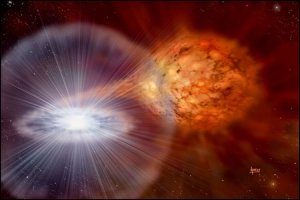 Artist's impression of a Type Ia Supernova
Artist's impression of a Type Ia Supernova
explosion. A white dwarf (left) steals the matter from the
outer envelopeof a red giant companion (right) until it can
no longer support the weight. The resulting explosion
can be seen across the universe. Credit: David A. Hardy,
www.astroart.org & PPARC
I'm writing this from the plane on a flight back to SFO from Colorado. I just spent the last week in Aspen at the Center for Physics in a supernova workshop. Yes, you heard right, we actually have workshops on supernovae!
You may wonder how it is that a group of people could spend an entire week discussing exploding stars. Well, I'll tell you, there's a lot we don't know about them. If you ask around, you'll find astrophysicists who have been studying supernovae for their entire professional careers, and who still don't have it figured out.
Before I start with all the things we don't yet know, let me tell you a couple of the things we do know. First of all, as I mentioned above, a supernova is an exploding star. Roughly speaking, there are two classes, the core collapse and the Type Ia.
A large star (eight times more massive than the Sun) will die in a core collapse event when it burns off the last of its fuel. Without any fuel to burn, the nuclear explosions at the center stop firing, and no longer support the star against its own gravity. When this happens, the star implodes in a burst of light, energy and heavy elements, leaving behind a neutron star or a black hole, depending on the size of the original star.
